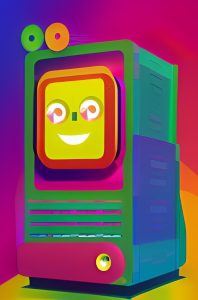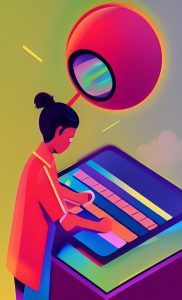Artificial Intelligence and Its Impact on K-12 Education
A few months ago, students and teachers woke up to discover the public release of online tools with the power to transform teaching and learning. Because this disruption comes at unprecedented speed, the IMSA Statewide Education Innovation team created this page as an introduction for educators seeking more information. This page ends with links to even more information and will be updated as necessary to reflect the most common concerns. Ultimately, the advent of easily accessible Artificial Intelligence will be of great benefit to the educational community. We will be here to help you make use of this powerful new tool.
 What is AI?
What is AI?
Artificial intelligence (AI) is the simulation of human intelligence processes by machines. These processes include perceiving, synthesizing, and inferring the information necessary for solving problems. The term may also refer to the computer software that accomplishes these processes.
Someday a “general purpose” AI may be capable of doing any cognitive task as well as a typical human being. Such an AI could be trained to do any mental task that we might currently assign to a person. At the moment, however, each AI is trained to become an expert at one particular type of thinking. This expertise comes from a process of machine learning in which the AI uses algorithms and a large data set to gradually improve its ability to recognize patterns. AI systems aren’t programmed to know things. They are programmed to learn.
Examples of AI in our everyday lives:
- Internet search engines
- Google maps and other navigation systems
- “Recommended for you” lists on websites such as Amazon, Netflix, Spotify
- Feeds on social media platforms
- Grammarly and similar writing assistants
- Sentence completion functions on cell phones and email software
- “Chatbots” like ChatGPT

Near-Term Challenges for Classroom Teachers
It is now possible for students to use a free online AI to produce any sort of writing, including those writing assignments traditionally used for practice and assessment in the classroom. Essays, research papers, lab reports, computer codes, and even digital art can be produced by students with very little effort or understanding through the use of AI. The AI’s style will be a bit formulaic and its information may sometimes be inaccurate, but it can mimic what a teacher might expect of student work. This opens the door to academic dishonesty if a student is using AI without the teacher’s permission.
Some online services offer the promise of software that can detect the use of AI, but there are reasons to doubt that it will ever keep pace with the tools available to students. The bottom line is that teachers can no longer reliably know the authorship of any digital expression. Many teachers will need to make thoughtful adjustments to how they assess student learning. This should not cause more than a moment of anxiety. Teachers generally enter the profession because they love teaching and working with students, not the application of any particular assessment technique.
.
.
 Current Potential
Current Potential
AI can be a useful tool to develop one’s writing skills and teachers can help students use AI in appropriate ways. Rather than giving students a prompt for an essay or research topic, for example, a teacher can instruct students to give that prompt to an AI. Students then analyze the response for currency, relevance, and accuracy, as well as writing style. One extension would be to have students rewrite the response to correct its deficiencies. Another would be to revise the prompt to elicit a better, more useful response from the AI.
.
.
Useful links for learning more about AI and K-12 education
Percent Human: A list of tools for detecting lower-quality AI content
AI Homework – Implications of a popular AI, from Stratechery
A new AI chatbot might do your homework for you. But it’s still not an A+ student
ChatGPT: Everything you need to know about OpenAI’s GPT-3 tool
Leveraging ChatGPT: Practical Ideas for Educators
ChatGPT and Solving Math Problems
11 ways you can use ChatGPT to write code
.
.
** All images on this page were generated using the Dream AI by Wombo and edited by the author.



